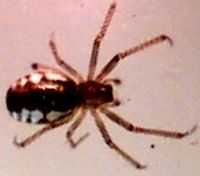Sheetweb spider
| Cambridgea | |
|---|---|
 | |
| Cambridgea foliata | |
| Scientific classification | |
| Kingdom: | Animalia |
| Phylum: | Arthropoda |
| Class: | Arachnida |
| Order: | Araneae |
| Suborder: | Araneomorphae |
| Superfamily: | Lycosoidea |
| Family: | Stiphidiidae |
| Sheetweb spiders | |
|---|---|
 | |
| Bowl and doily spider, Frontinella communis | |
| Scientific classification | |
| Kingdom: | Animalia |
| Phylum: | Arthropoda |
| Class: | Arachnida |
| Order: | Araneae |
| Suborder: | Araneomorphae |
| Family: | Linyphiidae |
| Subfamily: | Linyphiinae |
| Genera | |
|
Frontinella | |
| Wikispecies has information related to: Linyphiinae |
The sheetweb spiders are either of the family Stiphidiidae[1] or of the family Linyphiidae subfamily, Linyphiinae, of sheet weavers. There are more than 800 described species.
In some taxonomies, the subfamily Micronetinae is classified within Linyphiinae as the tribe Micronetini.
New Zealand has a variety of species in the family Stiphidiidae. The largest of New Zealand's sheetweb spiders is Cambridgea foliata. The body length may be up to around 2.5 centres with a span of up to around 15 cm. It produces webs like a sheet (hence the name) up to a metre across. It is forest dweller and trampers may encounter the webs though they rarely encounter the spider itself which is nocturnal, spending the day time inside a web tunnel. It will also live in gardens. Male spiders may enter human homes where their size, including their centimetre long fangs, may be intimidating though the spider itself is considered harmless to humans and bites are extremely rare.[1][2]